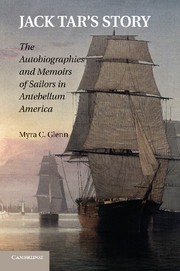Book contents
- Frontmatter
- Contents
- Acknowledgments
- List of Abbreviations
- Introduction: Why Study Antebellum Sailor Narratives
- 1 Stories of Escape, Freedom, and Captivity: Seamen Authors Recall Their Early Years
- 2 Manhood, Nationalism, and Sailor Narratives of British Captivity and the War of 1812
- 3 Exploring the Meaning of Revolution in the Americas: Sailor Narratives of the Haitian and South American Wars of Independence
- 4 Defending One's Rights as a Man and an American Citizen: Sailor Narratives as Exposés of Flogging
- 5 Straddling Conflicting Notions of Masculinity: Sailor Narratives as Stories of Roistering and Religious Conversion
- Afterword
- Appendix
- Index
3 - Exploring the Meaning of Revolution in the Americas: Sailor Narratives of the Haitian and South American Wars of Independence
Published online by Cambridge University Press: 05 October 2010
- Frontmatter
- Contents
- Acknowledgments
- List of Abbreviations
- Introduction: Why Study Antebellum Sailor Narratives
- 1 Stories of Escape, Freedom, and Captivity: Seamen Authors Recall Their Early Years
- 2 Manhood, Nationalism, and Sailor Narratives of British Captivity and the War of 1812
- 3 Exploring the Meaning of Revolution in the Americas: Sailor Narratives of the Haitian and South American Wars of Independence
- 4 Defending One's Rights as a Man and an American Citizen: Sailor Narratives as Exposés of Flogging
- 5 Straddling Conflicting Notions of Masculinity: Sailor Narratives as Stories of Roistering and Religious Conversion
- Afterword
- Appendix
- Index
Summary
American mariners who sailed the high seas in the late eighteenth and early nineteenth centuries quickly learned that they were living in a revolutionary age. This was especially true for those seamen who sailed to the Caribbean and to South America. Revolution began in the French Caribbean colony of Saint-Domingue in 1791 when enslaved blacks rebelled against their plantation masters as well as French rule. To highlight their independence from French colonialism black revolutionaries began to call their island nation “Haiti,” a name long used by the indigenous people, the Tainos.
By the first decade of the nineteenth century revolutionaries in Central and especially South America were campaigning against Spanish rule and demanding independence. Late in 1805 Francisco de Miranda, a quixotic Venezuelan revolutionary living in exile in London, traveled to New York City where he organized a naval expedition back to his homeland. He hoped to topple the colonialist government in Venezuela and instigate a war of independence throughout Latin America. Although Miranda's mission failed, he helped to educate and infuse with revolutionary fervor the next generation of independence leaders, Simón Bolívar and José de San Martín. These men realized Miranda's dreams by leading Latin America's wars of independence from 1808 to 1826.
How did U.S. mariners who witnessed these developments interpret them? Chapter 3 explores this question by focusing on the autobiographies and memoirs of sailors who left especially rich accounts of their experiences in revolutionary Haiti and South America.
- Type
- Chapter
- Information
- Jack Tar's StoryThe Autobiographies and Memoirs of Sailors in Antebellum America, pp. 84 - 111Publisher: Cambridge University PressPrint publication year: 2010



